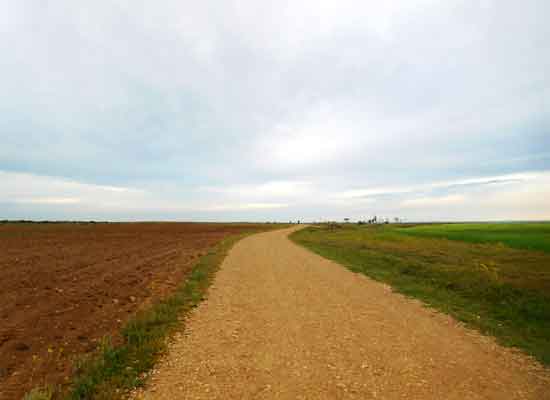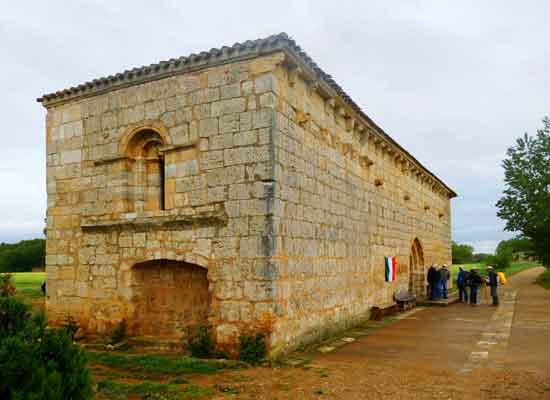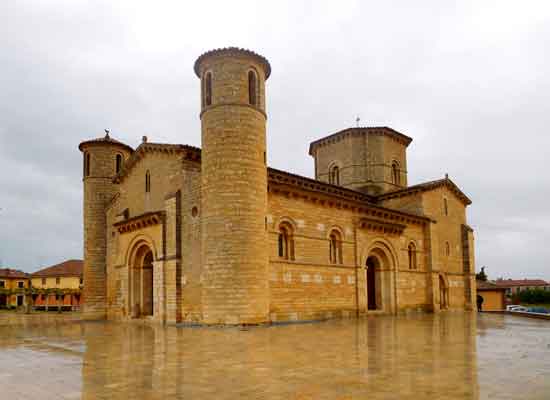Step by Step on The Way of Saint James
From Castrojeriz to Frómista
25 May 2018
Stage 15 – Km. 25

As I mentioned earlier, making a stop here in Castrojeriz was a strategic choice to shorten by almost ten kilometres the route we will face today.
After having breakfast with croissants and fruit juice, purchased yesterday at the supermarket, we leave the hostel at 6:30, just as the first light of day appears.
It will likely be at least a couple of hours before we reach the next village where we can eat something more substantial.
This morning is colder than usual, and I suspect it even rained overnight, given the wet ground.
The sky does not look promising, and we will probably face rain during the day.
Shortly after Castrojeriz, the path is flat and unpaved.
We cross the Río Odra via the Puente Largo de Bárcena, a medieval stone bridge—low, narrow, and long—with several arches.
Nowadays, the bridge is almost invisible to those crossing it: it has no side parapets, the surface is dirt, and weeds have taken over.
I only realise I had walked over a bridge after I’ve crossed it.
A little further ahead, there is a peak reaching 930 meters above sea level, briefly interrupting the “meseta”—this is Alto de Mostelares.
The ascent is neither challenging nor particularly long, but the incline takes your breath away a bit: nearly 150 meters of elevation gain in less than two kilometres, with a 12% gradient.
At the top, we discover a stone monument.
Beside it, there is also an iron cross adorned with various rags and other symbols left by passing pilgrims; at its base, there is the customary pile of stones, along with various meaningful items for those who left them: photographs, hats, a pair of boots, and even a rubber clog, the kind with large holes, like “Crocs.”
Despite the strong, chilly wind, we stop for a few minutes to catch our breath and take some photos—both of ourselves next to the monument and of the vast 360-degree panorama.
We can see the plain we’ve come from, and looking west, we can also glimpse the landscape we’ll be crossing next. It’s the so-called Tierra de Campos, the boundless and steppe-like Castilian meseta that we will traverse over the coming days. The vast land presents itself to our eyes as a patchwork of fields in varying shades of green.

Alto de Mostelares extends flat for only a short distance before descending about a hundred meters, this time with a steeper slope than the ascent.
At the bottom of the descent, we proceed along a flat and straight dirt path that cuts through a barren landscape with no tall vegetation—the cultivation of cereals dominates the scenery along our route.
– In its poignant desolation, it remains a fascinating and “beautiful” landscape! –
The sky is still overcast, but I dare to hope we won’t catch the rain, as I see some breaks in the clouds in the distance.
– With the wide view offered by the “mesetas,” weather forecasts can easily be made with the naked eye. –
We walk for an hour and a half without noticing significant changes in the landscape we’re crossing.

Around nine o’clock, we arrive at the hospital de Peregrinos San Nicolás de Puente Fitero, a hostel located in a remote corner of Castile, established and managed by Italians affiliated with the Confraternity of Saint James in Perugia.
The hostel was built by the same members who restored the abandoned church of San Nicolás, originally constructed in Romanesque-Gothic style.
Hospitality and assistance to pilgrims are at the core of the mission of this modest structure, which remains open from June to October.
Many pilgrims, from all nationalities, stop here to find food and shelter.
Every evening at San Nicolás, under the marvellous medieval apse, the ritual of foot washing takes place; a tradition carried forward from the Middle Ages, combining hygiene with Christian symbolism.
Afterwards, a prayer is recited, asking for strength for the pilgrim to complete The Way to Santiago de Compostela, and finally, dinner is shared by candlelight, prepared by the confraternity members, who also serve as “hospitaleros.”
Supervising the hostel, we find three Italian men.
They welcome us kindly, offering us coffee and explaining how the facility was created and how one can become a volunteer “hospitalero.” Only those who have completed The Way of Saint James at least once can apply to the Confraternity in Perugia, offering to cover a 15-day shift.
Before leaving this pleasant stop, we have our credentials stamped with the Confraternity’s seal.
A hundred meters ahead, we reach the Río Pisuerga, the river marking the boundary between the provinces of Burgos and Palencia.
To cross the river, we walk over the Puente Fitero, one of the most beautiful and longest bridges along The Way of Saint James. Located in the municipality of Itero del Castillo, it was built at the beginning of the 12th century in Romanesque style and later modified during the Gothic period.
Today, the stone bridge features seven of its original eleven arches but still retains the same charm and strategic importance it had in medieval times, earning it several mentions in the famous Codex Calixtinus.
The “Liber Sancti Jacobi,” known as the Codex Calixtinus, is a 12th-century work attributed to Pope Callixtus II. It is a collection of five books containing texts written in Latin at different times, compiled, organized, and revised by the cleric Aymeric Picaud.
The books discuss the spirituality and practical aspects of the pilgrimage; miracles attributed to the intercession of the Apostle; the transportation of Saint James’s body from the Holy Land to Galicia; the ancient pilgrims’ tradition of collecting scallop shells upon reaching the Galician beaches; the dream appearance of Saint James to Charlemagne, urging him to liberate his tomb from the Muslims and showing him “a path of stars” to follow; the epic Battle of Roncevaux and the death of Roland.
However, the most famous book is the fifth, “Liber Peregrinationis”, also known as “The Pilgrim’s Guide”, which provides an authentic account of 12th-century pilgrimages.
***
Once across the Puente Fitero, we enter the province of Palencia, and after about a kilometre and a half, we reach Itero de la Vega. From here onwards, the monotony of the landscape and a relentless rain accompany us along the Jacobean route for eight, seemingly endless, kilometres until the next town.
Arriving in Boadilla del Camino, we see the main church of the town, the Iglesia de Nuestra Señora de la Asunción, built between the 15th and 16th centuries on the site of an older Romanesque church. Unfortunately, it is closed, so we cannot visit its interior, which is particularly interesting for its art and history.
Near the same church, in the main square, stands the Rollo Gótico Jurisdiccional, a symbol of the town’s judicial independence. This monument, built in the 15th century, consists of a circular base with five steps, from which rises a three-and-a-half-metre column richly decorated with motifs inspired by The Way.
In the past, the Rollo was used both for public executions and for chaining the accused while awaiting trial, thus exposing them to public humiliation.
***
Today marks my fifteenth consecutive day of walking, and considering that there are thirty stages to Santiago de Compostela, I can confidently say I’m exactly halfway through the total number of days needed to complete The Way.
So far, I’m very satisfied with my physical condition.
In the past, thinking about this particular itinerary, I often doubted whether I would be able to complete such an undertaking.
I’ve always done trekking, including long and challenging routes, but they generally never lasted more than one or two days. At most, I’ve walked for four consecutive days on two different itineraries, years apart: the first took me across the four valleys from Menaggio, on Lake Como, to Lugano, on its Swiss counterpart; the second, in Nepal, was at the foot of Machhapuchhare, starting from Pokhara.
Thinking about The Way of Saint James, I always wondered how my body would respond to such a prolonged effort—walking so many kilometres every day for over a month.
And yet, here I am. After two weeks, I’ve already covered about 330 kilometres, and apart from the usual tiredness after a long walk, I can report no significant pain. I haven’t experienced the common ailments that plague many walkers, such as tendinitis in the ankles or knees.
Even the much-feared blisters, the scourge of many pilgrims, haven’t been much of a problem for me—except for a small one under my right foot, which I’ve already mentioned, but which healed quickly in just a couple of days.
By now, waking up early in the morning and setting off soon after to cover a good number of kilometres has become a habit—a natural routine that rewards me with the landscapes I cross and the satisfaction of reaching each day’s stage.
– At this point, I’m starting to feel like Superman! –
Although there have been, are, and will be countless others like me, I feel justified in thinking I’m from the planet Krypton because The Way of Saint James must be tackled with mental strength and inner determination before relying on legs and feet.
I’ve made this long preamble because everything I’ve said so far holds true until today—or rather, until this very moment.
Unexpectedly, and from one step to the next, I feel sharp pains in both shins, the part of the legs between the knees and ankles.
It’s as if a red warning light has suddenly started flashing in my system, accompanied by a blaring siren signalling that something inside me has broken.
Of all the possible aches I had anticipated enduring during The Way, I had never considered shin pain. Moreover, I can’t recall ever hearing anyone mention such an issue before.
I can’t even explain why this pain has appeared now, given that today’s route presents no particular challenges. Apart from the climb and descent of Alto de Mostelares this morning, the rest of the trail has been flat and on compact ground.
***
It’s around 12:30, and the rain has stopped.
I decide to take a break here in Boadilla del Camino. Maybe this pain is only temporary, and a bit of rest will fix it.
I settle down in a bar, where I find other pilgrims, both familiar and unfamiliar, and order my usual tortilla with freshly squeezed orange juice.
Meanwhile, I take off my shoes, massage the painful areas, and do some stretching—none of which seems to help, as the pain persists.
The temptation to end today’s stage here is strong, but my willpower pushes me to continue and cover the six kilometres remaining to Frómista, today’s planned destination.
I set off slowly, telling my friends Rocco and Dante not to wait for me and to go on ahead. After all, as I’ve mentioned before, it’s best for everyone to walk at their own pace without speeding up or slowing down to match others.
I hope to arrive soon, take a hot and relaxing shower, and spend the afternoon resting.
The path is still entirely flat and unpaved; the good news is that it’s no longer raining, although the sky remains overcast.
Despite the pain, I manage to keep a fairly steady pace, so much so that my two trusty companions are not far ahead of me. I can still see them in the distance because they are easy to recognise: Dante wears a blue rain jacket and is distinguishable by the small cart he constantly pulls, while Rocco wears a billowing red poncho that covers both his backpack and the smaller bag he carries in front, making him look like Gabibbo, as we’ve jokingly called him a few times.
A couple of kilometres after Boadilla del Camino, the path intersects the Canal de Castilla—an important hydraulic engineering project built in the 18th century as a waterway for transporting cereals and other goods to Cantabria, solving the isolation problem of the Castilian meseta.
Today, the canal is a major attraction, hosting sporting events, excursions, and eco-tourism activities.
I walk alongside the canal almost until the end of the stage.
The surroundings are very beautiful: on either side of the canal, a long line of trees reflects in the green waters, and the soundtrack accompanying my progress is not bad either, made up of the repeated croaking of frogs and toads.
Just before reaching Frómista, the canal features a remarkable piece of historical hydraulic engineering—a sort of open-air museum that is still fully functional today. It’s a lock that allows the canal to overcome a 14-metre difference in height through a sequence of four levels.
At 14:00, I finally reach the Albergue municipal de peregrinos in Frómista, located opposite the cathedral.
After taking a shower, nibbling on some food from my personal supplies, and before lying down on my bed, I apply an anti-inflammatory cream for tendinitis from my travel pharmacy.
I rest until late afternoon, but despite my persistent leg pain, I can’t resist exploring the town. At 18:00, I leave the hostel to take a walk around town.
– Besides the tourist appeal that compels me to get back on my feet, I also need to find a place to have dinner, as my appetite is certainly intact. –

The Cathedral of San Martin is truly beautiful, not only because of its architectural features but also due to its position at the centre of the large square that surrounds it.
Moreover, as it is drizzling, the scene becomes even more evocative thanks to the mirror effect created by the wet pavement, which reflects the structure of the building perfectly—a visual feature that helps capture a stunning photo.
The church, built in 1066, was originally part of a Benedictine monastery and is one of the most beautiful and representative examples of Spanish Romanesque architecture in the province of Palencia.
Since its inception, it has served as a place of spiritual retreat for pilgrims heading to Santiago de Compostela.
The cathedral is characterised externally by two cylindrical towers at the corners of its façade, while its interior (accessible for a €1 fee) is divided into three naves, all covered by rounded barrel vaults and transverse arches. A valuable Gothic crucifix from the 13th century can be admired on the central altar.
Continuing the tour of the town centre, we come across the Renaissance façade of the Church of Santa María del Castillo. Shortly after, we focus on more practical matters: we buy groceries for tomorrow at a supermarket and look for a restaurant for dinner.
We consider several places, as not all of them offer a “pilgrim’s menu” and some are more expensive than usual.
After much searching, we settle on a restaurant not far from the hostel that offers an €11 menu. I opt for a mixed salad, a tasty trout, and finish with a creamy chocolate ice cream.
After dinner, I head straight to bed. Thankfully, the pains in my legs seem to have eased slightly, despite the walk around town.
| © Aldo Lardizzone 2020 |  |
CREATIVE COMMONS |



